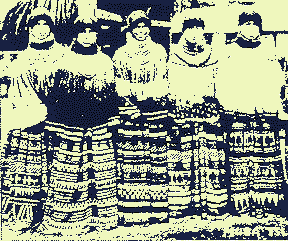Related stories: Seminole History Seminole Attractions Ah-Tha-Ti-Ki Museum Billy's Swamp Safari Publisher's Note


 Photo courtesy of Historical Museum of Florida |
| Right, a dugout canoe like the kind used to trade on the Miami River. |
The first versions of Seminole patchwork, from the late 1800's to the early 20th century evolved out of necessity. When cloth ran short, and a journey to town was not likely, women would take the small strips remaining from the ends of the cotton rolls and make strips out of the remnants. These were hand sewn into larger pieces for clothes, referred to as strip clothing. Necessity turned into wearable art.
The introduction of the sewing machine during the early 20th century caught the creative imagination of Seminole women. An Everglades explorer commented there were sewing machines in all the Seminole camps he visited in Southeast Florida. The sewing machine revolution transformed Seminole clothing.
In the 1920's, patchwork, now done with a machine, flourished. Women sewed with calicos, stripes, solids and plaids. They sewed not only to clothe their own families, but creatively, and to contribute to the growing tourist trade.
 Seminole/Miccosukee Photographic Archives Seminole women in the early 1930s. |
The Seminole Tribune notes, "Women's garments during this era consisted of a very full, floor-length skirt, gathered at the waist. A long sleeve blouse had an attached cape, trimmed with a ruffle, which came only to the shoulders and was very short. To complete the outfit, she wore as many strings of glass necklace beads as she could afford."
To continue, click here